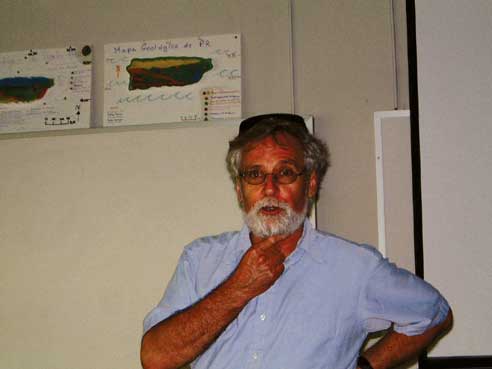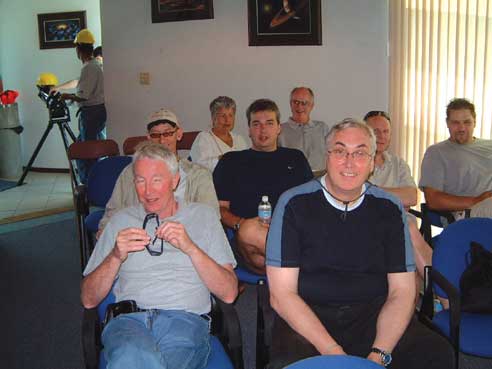To continue our coverage of international EMC
standardization, we now report on an IEC Special International
Committee on Radio Interference (CISPR) working group (WG) meeting
in San Juan, Puerto Rico the last week in June. The particular
working group that met is that associated with CISPR Subcommittee
I, which deals with EMC of information technology equipment (ITE),
multimedia, and receivers. Our gracious host was John Lichtig
of Lichtig EMC Consulting who chaired his WG3 meeting dealing
with the latest standardization maintenance of the well-known
CISPR 22 standard covering emissions for ITE products. John was
born and raised in Puerto Rico and helped to “translate”
the local color as he dealt with the hotel staff and of course
dining at historical restaurants dating back to the mid 1800’s.
But enough of the tourist pitch and on to what happened at this
WG meeting and the following task group meeting of WG2, which
deals with emission standardization of multimedia equipment. This
is scheduled to be published in the next couple of years as CISPR
32.
 |
| The sign at the entrance to observatory
with Don Heirman (left) of the USA and Ton Almering of The
Netherlands, both members of CISPR SC I/WG3. |
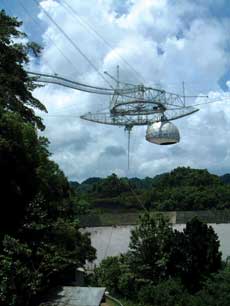 |
| Overall view of observatory telescope
showing the dish reflector and suspended receiver location. |
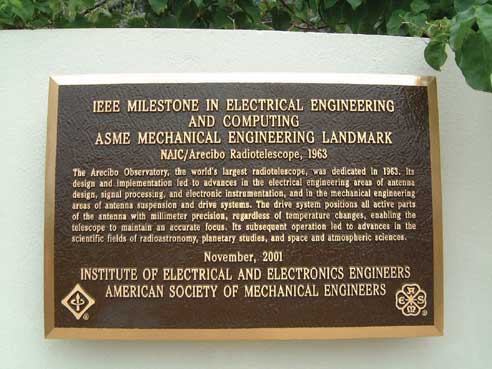 |
| The commemorative plaque placed on
the observation visitor platform shows the IEEE and ASME identifying
the observatory as a landmark installation. |
WG 3 had a full agenda covering the following topics largely covered
by task forces assigned by the WG. The decisions and discussions
follow each topic:
1. A report of the task force on impedance stabilization networks
for the telecommunication ports was presented that indicated that
a final draft international standard (FDIS) was being written
which will delete the 30 dB Longitudinal Conversion Loss (LCL)
ISN which is now in CISPR 22. There was no longer a need for this
ISN.
2. There is work proceeding by the task force on non-invasive
telecommunication port measurements. The thrust of this work is
to measure common mode current on cables attached to these ports
communicating with other ITE equipment without having to cut the
cable to insert a measuring device such as an impedance stabilization
network (ISN). The measurement is performed using a current probe
as well as a capacitive voltage probe.
3. The task force on test setups reported that their work was
completed with the publication of CISPR 22, Fifth Edition. However,
it was suggested that this task force remain in existence and
shift its activity to assisting and commenting on CISPR 32, which
is scheduled to replace CISPR 22 at some point.
4. The task force activity for developing a measurement method
and limits for power line communication systems is now a part
of the CISPR I subcommittee activity and no longer in WG 3. Note:
This CISPR I task force met the day before the WG 3 meeting at
the same venue and had over 20 attendees sorting through the work
necessary to achieve an amendment to CISPR 22 to measure such
systems and to provide acceptable limit levels.
5. The work on measurement instrument uncertainty continues with
the WG requesting that consideration be made to account for such
uncertainty in stating product pass/fail decisions, which are
demonstrated in standard CISPR 16-4-2. At present, only reporting
the uncertainty is required and not the need to take it into account
in unequivocally stating product passing or failing a limit. The
author was asked to draft a document for comment that will give
the national committees an opportunity to comment on adding the
full impact of measurement instrumentation uncertainty to state
pass/fail. If accepted, this would fully satisfy Publication 16-4-2.
6. There is considerable work by a task force on determining what
is the appropriate traffic loading that should be used when making
emission measurements on products sending/receiving such traffic
on their communication ports. It is of significant interest as
it was described that the difference in emissions may be as much
as 20 dB between systems with 10 percent (or idle) traffic to
those with 100 percent traffic.
7. Finally, it was reported and in a sense celebrated, that the
long road to derive limits above 1 GHz has met a successful end,
i.e. limits between 1 and 6 GHz have passed national committee
vote and will go into affect as an amendment to CISPR 22 probably
before the end of the year.
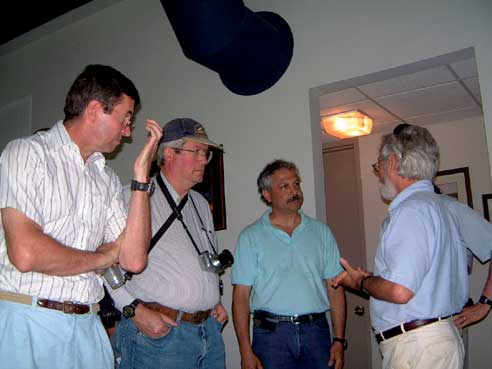 |
| Dr. Murray Lewis (far right) chats
with (from left) Steve Martin of the US FCC, Ghery Pettit
of Intel and WG 3 member, and John Lichtig, Chair of CISPR
SC I WG 3 and host for the WG 3 meeting, prior to start of
the observatory tour. |
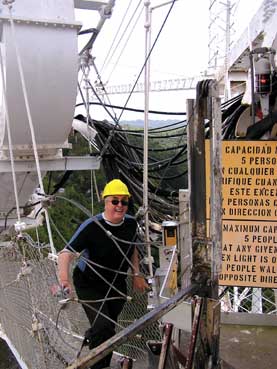 |
| CISPR Chairman Peter Kerry walks
“gingerly” on a catwalk to the center of the suspended
receiver of the telescope. |
 |
| CISPR WG 3 and WG 2 members inspect
the suspended receiver area, which shows the complicated structure
to help keep the receiver in focus with the reflector 145
meters below. |
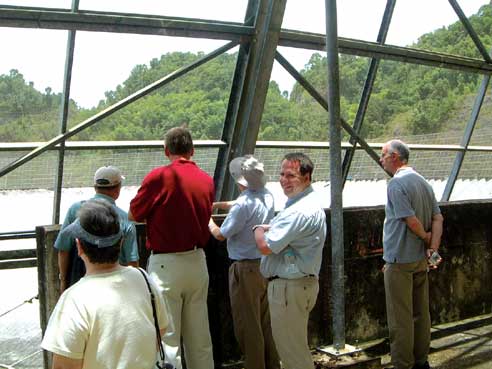 |
| WG 3 members view the observatory
reflector. |
The WG 2 task group on developing CISPR 32 met the next day and
then two days later. In the intermediate day, John arranged a
very special trip to the Arecibo Observatory and its National
Astronomy and Ionosphere Center outside San Juan. The observatory
is managed by Cornell University in the USA and is funded by the
US National Science Foundation. The observatory has the largest
curved focusing antenna (using the largest single-dish telescope)
on the planet measuring about 300 meters in diameter, 54 meters
deep with a focus suspended approximately 145 meters above the
reflector dish, which covers 20 acres. It is also an interesting
fact that the telescope provided the backdrop for two Hollywood
movies: “Golden Eye”, a James Bond flick with Sean Connery,
and “Contact” with Jodi Foster.
At the meeting venue next to the visitor center, Dr. Murray Lewis
(Senior Research Associate) and Dr. Jon Hagen (Assistant Director
for Technical Services) met with the CISPR attendees. Dr. Lewis
in fact arranged the visit for the over two dozen CISPR attendees.
After a brief introduction and review of the purpose of the observatory,
both gentlemen and representatives of the over 140 employees at
the site split the groups up and led them on a tour of different
parts of the campus and also gave them a tour of the facility.
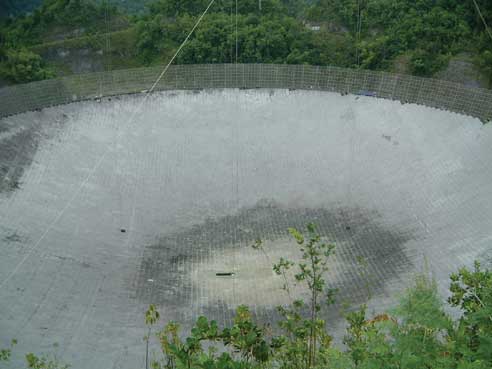 |
| The spherical reflector covers over
20 acres! |
The highlight of the tours was allowing the attendees (who were
not afraid of heights) to walk on the catwalk to the suspended
focus of the system where the sensitive receivers are located.
These receivers are able to listen to signals anywhere from within
our own galaxy and beyond to distant stars. The view was breath
taking as well as challenging to access portions of the observatory
as can be seen in the photos accompanying this article. Note the
president of CISPR, Peter Kerry, is shown above struggling along
the catwalk high above the reflector dish. Another photo shows
the intricacies of the suspended receiver structure. Even the
trip to the bottom of the reflector was memorable in noting that
the reflector was a portion of a perfect sphere and was constructed
to be within +/- 2 mm if a radius from the center of the sphere
traced the entire surface of the reflector! Other tours visited
the electronics laboratory where the controls that “aim”
the telescope are housed. During that portion of the tour, there
was also an opportunity to view the amplifiers that are used for
“active” tracking of objects using techniques similar
to radar. The operating frequencies are in the 450 and 2400 MHz
bands.
After the tours, the attendees reassembled and met again with
Dr. Lewis. Peter Kerry, CISPR President, presented a review of
what CISPR does and its responsibilities. Martin Wright followed
this, Chair of CISPR SC I, indicating the many projects that his
subcommittee was leading including the recent controversial standardization
on powerline communication. Following Martin’s presentation,
Don Heirman, Chair of CISPR SC A, spent time comparing the work
of his committee’s basic measurement and test instrumentation
work to that he heard during the tour of the observatory. For
example, the observatory design provided antenna gains of up to
70 dB around 450 MHz, which is close to 60 dB more than antennas
used in making radiated emission measurements at the same frequency.
In any case, the tour and discussions were quite memorable and
CISPR thanks the management and staff of Arecibo who spent so
much time with the attendees. For details on the observatory,
log into www.naic.edu.
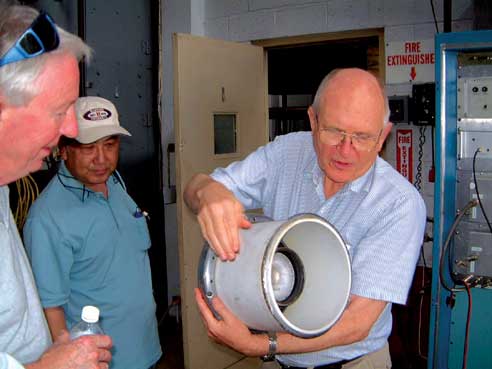 |
| Dr. Jon Hagen (right) holds a demonstrator
450 MHz amplifier component during the tour as Ron Storrs,
Chairman of CISPR SC I WG2, (left) and Fujio Amemiya, WG 3
member from Japan (center) watch intently. |
 |
| CISPR I WG 3 members view the 450
MHz amplifier used in the active probing of the solar system
work of the observatory. Dr. Hagen (far right) is explaining
its use. |
Back to the WG2 task group activity! Draft inputs were discussed
and amended and additional work was identified. The document starting
point was contained in CISPR/I/146/DC. Here the national committees
saw for the first time the intent of the combination of CISPR
22 and CISPR 13 (receivers) into a new all inclusive multimedia
form. There were over 125 comments on the DC (document for comment)
from the National Committees. The task group then started addressing
and hopefully resolving the comments as well as reviewing proposed
annexes including:
1. Annex A that shows the test setups for EUTs and those devices
which connect to and communicate with the EUT during compliance
testing. This annex is largely taken from the present CISPR 22,
Fifth Edition, except for including full frames such as those
for telecommunications switching offices as the work is focusing
on products which are sold everywhere, not commercial or professional
installations.
2. A companion annex that showed how to configure and exercise
the EUT. This included a matrix showing how to exercise ports
of the EUT including a new “H” pattern complete with
color bars according to ITU-R recommendation BT 471-1.
3. Annex B that provides product family test requirements and
clarifications including measurement automation techniques. The
proposed annex makes significant use of relevant parts of CISPR
16 test procedures which are contained in the CISPR 16-2-X series
of standards.
4. Annex C then proposed specific test setups for emission testing
for a wide range of product types. The task group decided to also
include a more generic test setup so that new product types would
not require yet another set of example test setup figures. But
for the moment, the test setups included those for:
 EMCS
Standards Activity: Old San Juan Hosts IEC/CISPR Standards WG Meeting
EMCS
Standards Activity: Old San Juan Hosts IEC/CISPR Standards WG Meeting









